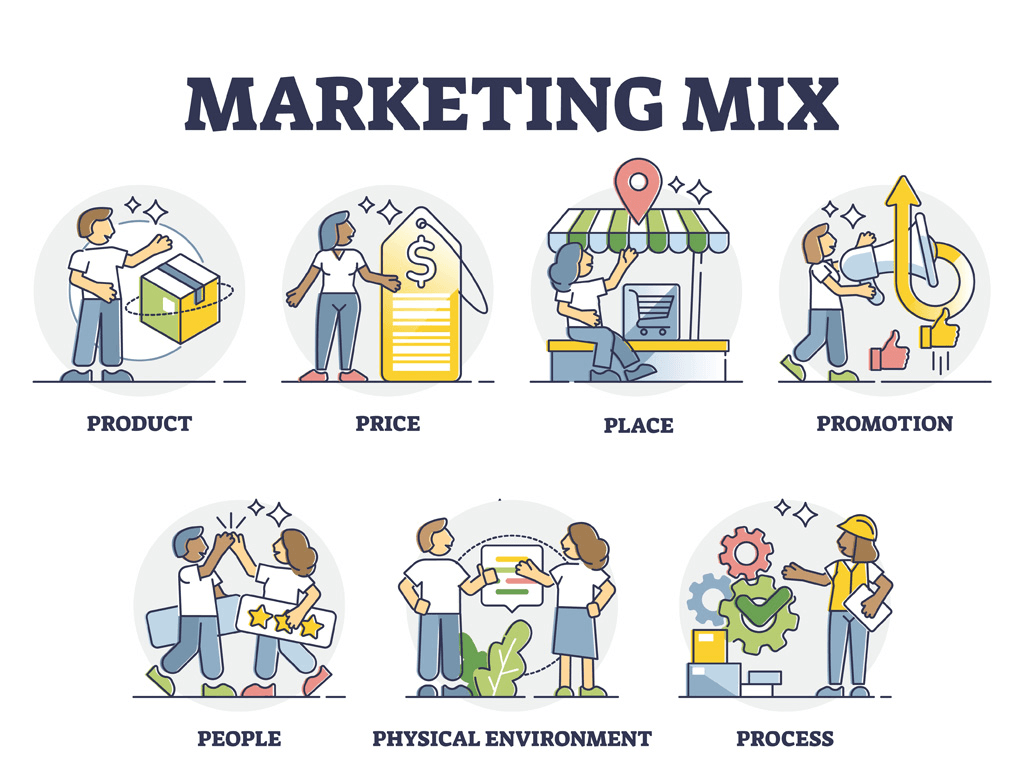 Image via. Pierre-Nicolas Schwab (“intotheminds.com”)
Image via. Pierre-Nicolas Schwab (“intotheminds.com”)
Picture this: you’re scrolling through your feed, and suddenly, an ad pops up—sleek design, catchy tagline, and just the right price to make you click. You start to think, “How do they know exactly what I need?” Well, my friend, you’ve just been schooled in the art of the Ps of Marketing. But hold up. Did you know there’s more to this game than the basic 4 Ps you might’ve heard of? Yep, we’ve leveled up to 7 Ps.
Let’s break it down and see why your favorite sneaker brand knows more about you than your Spotify Wrapped.
The original marketing rules: Product, Price, Place, Promotion
Let’s start with the old-timers, the "Original Gangsters" of marketing: Product, Price, Place, and Promotion. These are like the foundation of a marketing pyramid. Sure, they still get the job done, but we’re in the era of TikTok, where a viral soundbite can change a brand's trajectory overnight. The basics just aren’t enough anymore.
Product – This is what you’re buying. Whether it’s a pair of headphones or the latest skincare product from a brand you saw hyped up by influencers, the product has to serve a purpose, solve a problem, or spark joy.
Price – The big decider. How much are you willing to drop for this product? Is it worth its price tag? Here’s a tip: if a brand convinces you that spending an extra $100 on something will “change your life,” that’s marketing wizardry at play.
Place – No, unlike a physical store (although that counts). In today’s world, Place is where the magic happens—whether it's Instagram, Snapchat, or an Amazon product page that calls your name at 2 AM.
Promotion – Ads, emails, influencer shoutouts—this is where you get hooked. It’s the art of creating FOMO (Fear of Missing Out), convincing you that your life is missing something crucial without that product.
But, in today’s digital era, sticking to these 4 Ps is like showing up to a prom in last season’s fashion. Enter the 7 Ps, the ultimate marketing glow-up, and you’ve got yourself a winning formula that’s ready to slay the competition.
The Glow-Up: Process, People, Physical Evidence
As Gen Z would say, the 4 Ps had a vibe check and needed a glow-up. Here’s what they added to the squad.
Process – Imagine this: You order a pizza, and it takes two hours to arrive, only to be cold and missing half the toppings. Would you order from them again? Exactly. Process is all about how smoothly things go down. The process can make or break a brand's reputation, from how easy it is to buy a product online to how quickly it gets to your door.
Take the case of Amazon Prime. The company built its empire on a seamless, near-instantaneous delivery process. Amazon’s process is practically a meme at this point—order something at noon, and it’s on your doorstep by dinnertime. That kind of efficiency is what keeps customers coming back. The process is a crucial, often underrated part of the customer experience.
People – Ever been to a store where the employees are either zombies or flat-out rude? Yep, that’s where People come in. The people behind the brand (and even its influencers) make or break your interaction with it. From customer service reps to the face of a brand, every human touchpoint matters.
Example: Apple. Not just because of its products but also because of the customer service experience at its Genius Bar. The way Apple’s reps treat you can turn an average customer into a die-hard fan, and that’s why the company keeps winning loyalty wars.
Physical Evidence – This one’s a sleeper, but it’s crucial. It’s not just about the product but everything you can see and touch that represents the brand. Physical evidence is the tangible proof that a company is legit—whether it’s a website, packaging, or even the store layout. It’s all part of the experience.
Now, let’s look at Starbucks. Sure, they sell coffee, but it’s more than that. The cozy chairs, the smell of fresh brew, the jazz music playing softly in the background, and the whole atmosphere make you feel a little more sophisticated than you actually are.
Case Scenario: The Fast Fashion Frenzy

Image via. Shutterstock
Meet Zara, your go-to for affordable, trendy outfits. Zara nails the 7 Ps like it’s their runway show. Their product is always fresh because they churn out new styles in a matter of weeks. The price is just right—cheap enough to convince you to snag five outfits, even when you only came for one. Their place? Everywhere—both in chic malls and online, where their app lets you shop at 2 AM.
Now, they ace promotion by knowing exactly who their audience is: young, stylish, and budget-conscious. Their Instagram is filled with influencers and models rocking the latest trends, making you feel like you need that new coat.
But Zara’s secret sauce? The remaining Ps. Their process is seamless, from the ease of browsing to super-fast checkout. People in their stores are always quick to help. And the physical evidence? Those minimalist shopping bags and sleek store designs make the experience feel premium, even when you’re spending less than $50. It’s the full package.
Final Thoughts
The evolution from 4 to 7 Ps isn’t just a boring textbook concept; it’s why brands know exactly how to reel you in. The extra Ps? They’re the key to ensuring you’re not just a one-time customer but a loyal one. Next time you see an ad that feels like it’s speaking directly to your soul, remember: you’re being played by the 7 Ps, and it’s a game they’ve mastered.

